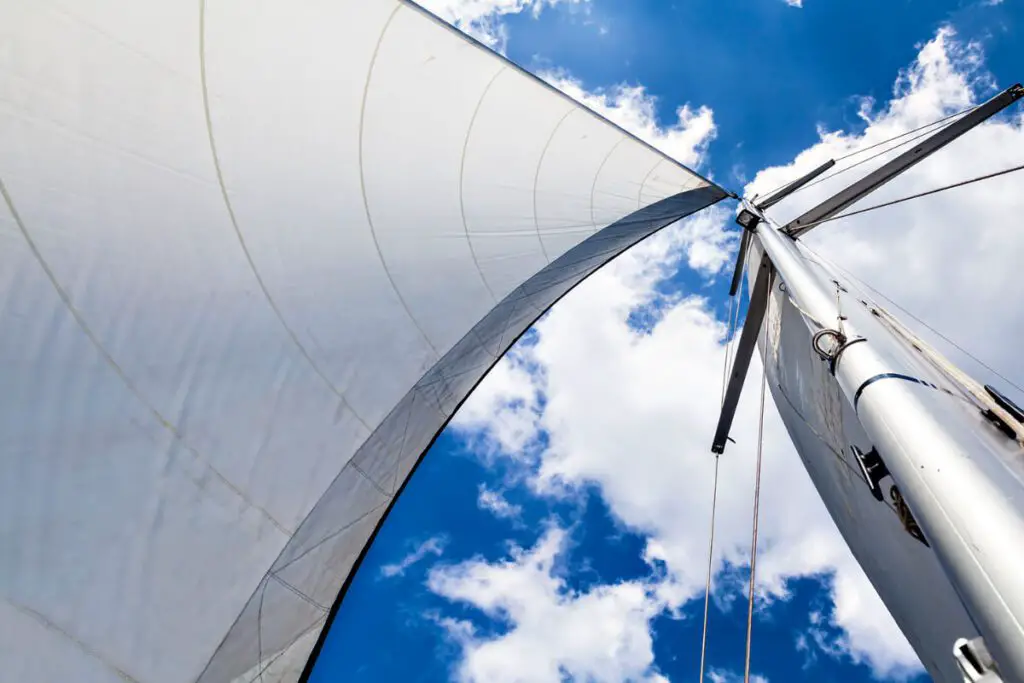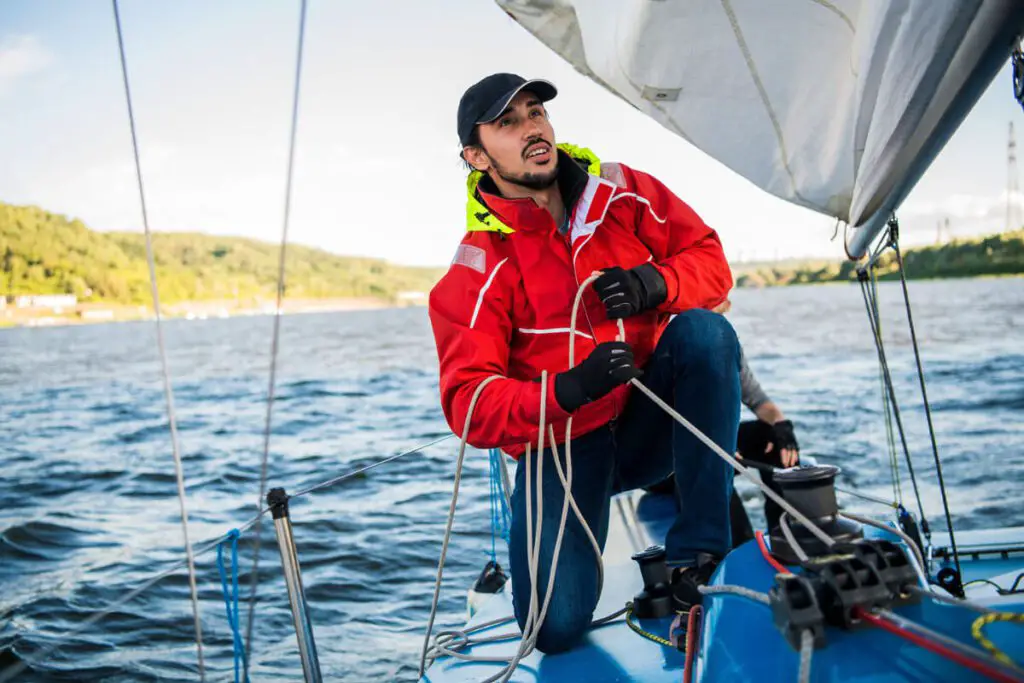If you are learning to sail, many sailors want to know what sails they should use to learn to sail with.
There are many reasons and circumstances when it may be best to sail with only the mainsail, especially if you are a beginning sailor. There can be some advantages to learning to sail with only the mainsail, but often this depends on where you are sailing, what the wind conditions are, and where you are learning to sail.
Table of Contents
- Beginning Sailor’s Sailing With Mainsail Only
- The Sailboat Goes Slower With Only The Mainsail
- You Do Not Need To Worry About The Jib Sail
- Allows Your To Concentrate On The Tiller If You Only Use Mainsail
- It Allows You To Concentrate On Tacks And Jibe Maneuvers.
- Can Concentrate On Learning About The Wind And Point Of Sail
- In Heavy Wind, Easier To Handle Sailboat With Only Mainsail
- Related Questions
Beginning Sailor’s Sailing With Mainsail Only
Here are some reasons why you may want only to use the mainsail if you are learning to sail. There could be other reasons, but here is the reason that I feel are some of the most important reasons for beginning sailors to use only the mainsail when sailing.
The Sailboat Goes Slower With Only The Mainsail
The sailboat will go slower when you have just the mainsail and do not have the jib sail up; for a beginning sailor who is not yet used to the feel of the sailboat’s wind and speed, having only the mainsail up may be an excellent way to get a feel for the wind and speed of the sailboat.

Even for some of the most experienced sailors, there may be wind conditions where they will bring the jib sail in and only sail with the mainsail.
Also, if you are learning to sail in a bay or area with a lot of boating traffic, you may find it safer to have only the mainsail up when you are learning to maneuver the sailboat.
You Do Not Need To Worry About The Jib Sail
If you are new to sailing, you can sail with the mainsail and not the jib sail, and then you do not have to worry about the jib sail. This can be an advantage for you, especially if you are getting used to the feel of the sailboat.

Whenever you tack or jibe the boat, the jib sail needs to crossover to the other side with the mainsail. If you do not have the jib sail up, then you do not need to worry about the jib sail also crossing over with the mainsail.
Allows Your To Concentrate On The Tiller If You Only Use Mainsail
Any experienced sailor will tell you that one of the most important things you can do when you are learning to sail is to get in some “tiller time.” Tiller time means you get as much time on the tiller as possible.
Part of the tiller time is learning to make many sailing maneuvers as a tack or jibe and not lose the mainsail. This may seem easy, but working the tiller properly with the mainsail does take time, skill, and experience.
It Allows You To Concentrate On Tacks And Jibe Maneuvers.
A basic maneuver for all sailors is the tack and jibe. A tack and jibe are how you move about in the wind and change the direction of the sailboat as the wind changes direction.

If you only have the mainsail to worry about in a tack or jibe maneuver, it is easier than having to also worry about the jib sail. There are some instances when you may want to practice your tack and gybe without the jib sail and only the mainsail.
Can Concentrate On Learning About The Wind And Point Of Sail
By having only the mainsail up, you can concentrate on learning about the wind direction and wind speed. One of the hardest things for a beginning sailor is understanding how to work the sail with the wind direction.
One of the keys is that you need to be able to read the telltales on the sails so that you can understand which point of sail you are on. If you are in close reach, you need to bring the mainsail in; you must bring it out if you are on the broad reach.
By only having the mainsail to worry about, you can start to concentrate and learn about your points of sail, where your mail sail should be for each point of sail, and the direction the wind is blowing. Once you have learned, adding the jib sail into the mix is more manageable.
Most outstanding sailors will look at the telltales and the wind to understand the direction from which the wind is coming. They read the telltales like you would road signs on the road to know what direction you need to go.
In Heavy Wind, Easier To Handle Sailboat With Only Mainsail
If you are learning to sail in an area with heavy air or even gusts of heavy air, it is easier to handle the sailboat with only the mainsail. If you are sailing in these conditions, it may be the safest to sail first with only the mainsail and learn to master all the basics of the sailboat and sailing and then add the jib sail to your sailing experience.
Even very experienced sailors, who are out in heavy wind conditions, may bring the jib sail in or bring it partly in so they can have better control of the sailboat.
The thing about learning to sail is that there is usually not one set answer that is right for everyone. Some people learn to sail with the jib and mainsail, and others learn to sail with just the mainsail. There is no right answer as to what is correct, as it is an individual choice.
Sailing with or without the jib for a beginning sailor is an individual choice.
At A Bus On A Dusty Road, we talk about travel, life, sailing, and ex-pat living. We are all about “Living Life As A Global Citizen.” We explore social, cultural, and economic issues and travel.
We would love to have you be part of our community. Sign up for our newsletter to keep up-to-date by clicking here. If you have any questions, you can contact me, Anita, by clicking here.
Listen to our Podcast called Dusty Roads. You can find it on all major podcast platforms. Try out listening to one of our podcasts by clicking here.
Subscribe to our A Bus On A Dusty Road YouTube Channel with great videos and information by clicking here.
Related Questions
Milwaukee Community Sailing Center, Top US Sailing School
Milwaukee community sailing center is located on Lake Michigan in downtown Milwaukee Wisconsin. The sailing center is registered as a charity whose primary focus is to teach basic, intermediate, and advanced sailing classes to adults, youth, and children. They are also a charity 501c3 organization that helps many underprivileged children learn the art of sailing.
By clicking here, you can discover Milwaukee Community Sailing Center, Top US Sailing School.
How Much Wind Is Too Much For A Beginner Sailor?
For a beginner sailor, the wind is usually recommended to be under 10 knots. Those who are more experienced or with a larger boat can consider going up to 12 knots of wind. A knot is not the same as miles per hour or kilometers per hour but is faster than these measurements.
By clicking here, you can discover How Much Wind Is Too Much For A Beginner Sailor?
No Experience Sailing, 6 Tips To Get Started
If you are going to take up sailing, then the first thing you must do is get on a boat and find out if sailing is suitable. The best sailors can handle their boats in all kinds and types of weather. Find a class that you can join and get certified. Sailing requires knowledge and skill. Find yourself a sailing community that you can be part of.
By clicking here, you can discover No Experience Sailing, 6 Tips To Get Started.


